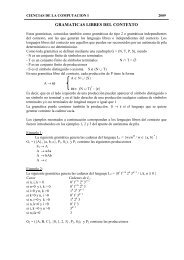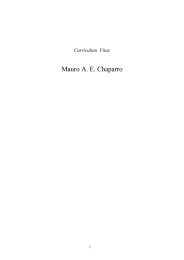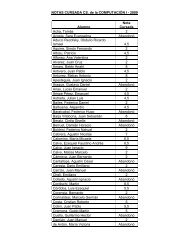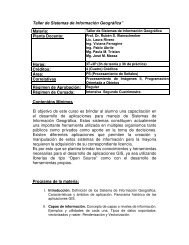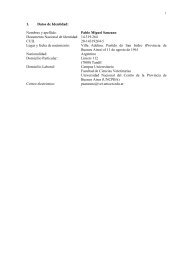Libro de Resúmenes / Book of Abstracts (Español/English)
Libro de Resúmenes / Book of Abstracts (Español/English)
Libro de Resúmenes / Book of Abstracts (Español/English)
Create successful ePaper yourself
Turn your PDF publications into a flip-book with our unique Google optimized e-Paper software.
Resumenes 67<br />
There exists wi<strong>de</strong> evi<strong>de</strong>nce that P. darwini presents changes in<br />
behavior as antipredator response [6] that tend to diminish its exposure to<br />
predation. These behavioral responses refer mainly to a greater use <strong>of</strong><br />
physical refuge, that AIDS a lower presence in open areas.<br />
In this way, we assumed that the vulnerability V = V(P) <strong>of</strong> P darwini<br />
(probability <strong>of</strong> being killed by predator) diminishes as an effect <strong>of</strong> the<br />
behavioral changes in the presence <strong>of</strong> predators.<br />
One way to express vulnerability is through the function:<br />
V<br />
P<br />
=<br />
( 1−<br />
V )<br />
P<br />
+ V<br />
P + PV<br />
=<br />
α u<br />
u α<br />
( )<br />
α<br />
,<br />
P + Pu<br />
P + Pu<br />
where P = P(t) is the predator population size, Pu is the amount <strong>of</strong><br />
predators that provokes an antipredatory behaviour and V α is the minimum<br />
value <strong>of</strong> vulnerability. This function <strong>de</strong>pends on the predator <strong>de</strong>nsity and is<br />
monotonically <strong>de</strong>creasing; that is to say, when there are more predators,<br />
ro<strong>de</strong>nts assume the antipredatory behaviour diminishing vulnerability (there<br />
is lesser probability <strong>of</strong> <strong>de</strong>ath).<br />
We assume that the growth function in the ro<strong>de</strong>nt population is <strong>of</strong> a<br />
logistic type which inclu<strong>de</strong>s <strong>de</strong>nsity-<strong>de</strong>pen<strong>de</strong>nce as principal form <strong>of</strong><br />
population self-regulation and that they have a food resource without<br />
restrictions. The extraction <strong>of</strong> prey by predators (functional response) is <strong>of</strong> a<br />
Beddington-DeAngelis type which incorporates the hyperbolic response with<br />
interference among predators.<br />
On the other hand, the equation that <strong>de</strong>scribes the predator<br />
population growth is also <strong>of</strong> a logistic type where the predator's carrying<br />
capacity is directly proportional to the prey <strong>de</strong>nsity [5]. Then the proposed<br />
mo<strong>de</strong>l is <strong>of</strong> a Leslie type [5] and is <strong>de</strong>scribed by the differential equations<br />
system:<br />
X<br />
µ<br />
⎧dN<br />
⎛ N ⎞ qN<br />
⎪ = r⎜1−<br />
⎟N<br />
−<br />
P<br />
⎪ dt ⎝ K ⎠ V ( P)<br />
N + bP + a<br />
⎪<br />
: ⎨<br />
⎪<br />
⎪dP<br />
⎛ P ⎞<br />
= s<br />
⎪ ⎜<br />
⎜1−<br />
⎟ P<br />
⎩ dt ⎝ n g(<br />
N,<br />
P)<br />
⎠<br />
7<br />
where µ = ( r,<br />
K,<br />
q,<br />
b,<br />
a,<br />
s,<br />
n)<br />
∈ℜ<br />
+ and the parameters have different biological<br />
meanings. Moreover, the function g(N, P) indicates the amount <strong>of</strong> prey<br />
nee<strong>de</strong>d by each predator to sustain the permanence <strong>of</strong> predator population,<br />
that is,<br />
φ N<br />
g(<br />
N,<br />
P)<br />
=<br />
V ( P)<br />
N + bP + c<br />
we show that (0,0) is a non-hyperbolic attractor point, then this mo<strong>de</strong>l<br />
predicts that both populations go to extinction.<br />
Referencias



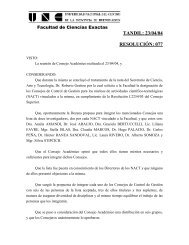
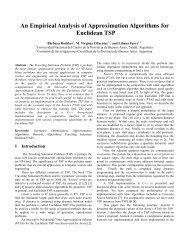
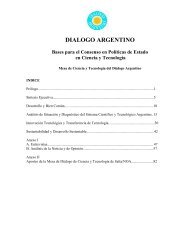


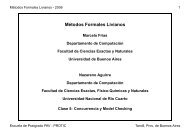
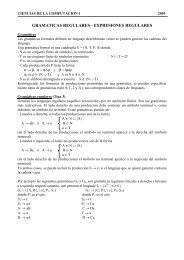
![Clase 13 [pdf]](https://img.yumpu.com/19616969/1/190x245/clase-13-pdf.jpg?quality=85)


